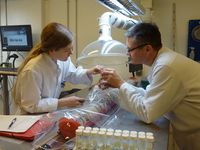Difference between revisions of "Transport parameters and contaminant data"
m (→Contaminant data) |
m |
||
| Line 14: | Line 14: | ||
Important transport parameters that influence the migration of a substance are | Important transport parameters that influence the migration of a substance are | ||
* diffusion coefficient of the substance in the limestone (often estimated as molecular diffusion coefficient times the tortuosity or porosity of the limestone) | * diffusion coefficient of the substance in the limestone (often estimated as molecular diffusion coefficient times the tortuosity or porosity of the limestone) | ||
| − | * dispersivities | + | * dispersivities (may be less important, if fracture flow dominates) |
| − | * sorption coefficient | + | * sorption coefficient (organic carbon is usually low in limestone) |
* limestone porosity | * limestone porosity | ||
| − | * degradation | + | * degradation rates |
'''Tracer tests''' are very useful to analyze the transport behavior in a limestone aquifer. | '''Tracer tests''' are very useful to analyze the transport behavior in a limestone aquifer. | ||
| Line 30: | Line 30: | ||
Furthermore, measurements from core material can be used to determine the porosity and hydraulic conductivity of a limestone sample, for example using gas permeameter and porosimeter (Poroperm test). | Furthermore, measurements from core material can be used to determine the porosity and hydraulic conductivity of a limestone sample, for example using gas permeameter and porosimeter (Poroperm test). | ||
| + | At the Akacievej site, this yielded porosity values between 7 adn 46 %, with a strong variation with depth. | ||
| + | The determined hydraulic conductivity values were correlated to the porosity (and limestone hardness) and were in the range of between 5x10-11 and 10-6 m/s, see | ||
| + | <ref name="Broholm2016"> Broholm et al. (2016), ''Sammenligning af niveauspecifikke prøvetagningsmetoder for vurdering af knocentrationsfordeling i kalkmagasin: Akacievej, Hedehusene.'' Technical University of Denmark, DTU Environment.</ref> | ||
== Contaminant data == | == Contaminant data == | ||
Revision as of 22:00, 5 February 2018
| Highlights |
|---|
|
Transport parametersAdvective transport happens due to the groundwater flow. However, to describe the transport of a substance in a fractured limestone aquifer properly, additional parameters are required. Important transport parameters that influence the migration of a substance are
Tracer tests are very useful to analyze the transport behavior in a limestone aquifer. Different types of tracer tests can be distinguished:
In the limestone project, a forced-gradient tracer test with several injection wells and a central pumping well for tracer monitoring was conducted. Details are described in the following report: Furthermore, measurements from core material can be used to determine the porosity and hydraulic conductivity of a limestone sample, for example using gas permeameter and porosimeter (Poroperm test). At the Akacievej site, this yielded porosity values between 7 adn 46 %, with a strong variation with depth. The determined hydraulic conductivity values were correlated to the porosity (and limestone hardness) and were in the range of between 5x10-11 and 10-6 m/s, see [1] Contaminant dataDifferent sampling and monitoring techniques to determine the depth-discrete contaminant distribution in boreholes have been developed. Depth-discrete sampling is important, since due to a very heterogeneous nature of the aquifer, the concentration can vary strongly over depth. For the planning of a site remediation it is important to know the vertical extent and the location of the contamination, so the remediation system can be planned most effectively. One way to obtain depth-discrete concentrations is to analyze small samples from borehole cores for the sorbed contaminant concentration. An example is shown in Figure 1. However, limestone has a very varying hardness and may be unstable. Soft limestone material is often lost when taking a borehole core. As a consequence, the core analysis is difficult and may lead to wrong results. The following list gives an overview of some other useful sampling methods in wells in limestone aquifers:
The following ones require open (unscreened) boreholes:
The following report gives a comparison of some of these sampling methods. |
- ↑ Broholm et al. (2016), Sammenligning af niveauspecifikke prøvetagningsmetoder for vurdering af knocentrationsfordeling i kalkmagasin: Akacievej, Hedehusene. Technical University of Denmark, DTU Environment.
- ↑ Broholm et al. (2016), Characterization of chlorinated solvent contamination in limestone using innovative FLUTe technologies in combination with other methods in a line of evidence approach, Journal of Contaminant Hydrogeology
